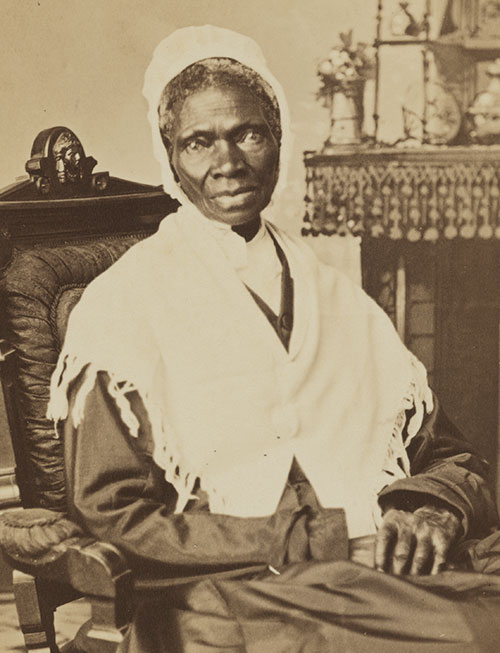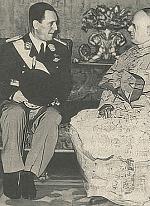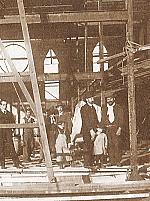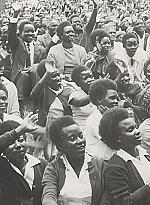When the Spirit moves: CH153 Gallery

[Randall Studio, Sojourner Truth, 1870. Albumen silver print—National Portrait Gallery / Public domain, Wikimedia]
Sojourner Truth (1797–1883)
Born into slavery in New York in 1797, Isabella Baumfree was bought and sold four times before the age of 20 and often treated brutally. With the help of a nearby abolitionist family, she gained her freedom.
After moving to New York City in 1828, she participated in the religious revivals sweeping the state and became an evangelistic speaker herself. In 1843 she renamed herself Sojourner Truth. Though she never learned to read or write, her oratory was famous for its rhetorical questions, incisive insights, and unsparing prophetic tone. She is best known for supporting abolition, women’s suffrage, temperance, and other social movements that worked toward equality for all. The autobiography she dictated, The Narrative of Sojourner Truth (1850), built her fame and economically sustained her.
Truth called her audiences to repentance: Christianity had no place for slavery or oppression of any groups. In an 1863 sermon, she declared,
Children, who made your skin white? Was it not God? Who made mine black? Was it not the same God? Am I to blame, therefore, because my skin is black? . . . Does not God love colored children as well as white children? And did not the same Savior die to save the one as well as the other?”
Her preaching and advocacy efforts continued from her home in Battle Creek, Michigan, as she worked for the Union cause during the Civil War and fought for equal rights in its aftermath. She met President Lincoln, worked for the Freedmen’s Bureau helping the formerly enslaved, and never stopped preaching the gospel and equal rights.
Florence Spearing Randolph (1866–1951)
Born into a free Black family in Charleston, South Carolina, Florence Spearing apprenticed as a dressmaker and built her own business, eventually relocating to Jersey City, New Jersey, where she married Hugh Randolph. A passion for public service led to involvement with temperance and women’s suffrage groups, active work in community improvement, and leadership in the local church and global missions.
Within the African Methodist Episcopal Zion (AMEZ) Church, she served as a Sunday school teacher and youth class leader, soon earning a reputation as an engaging speaker and mentor, eventually being appointed deacon, elder, and temporary pastor. With her leadership the church experienced exponential growth.
Randolph was tireless in the promotion of female church leaders and evangelists. In an important 1909 sermon, “Antipathy to Women Preachers,” she highlighted heroic women in the Bible, arguing that gender discrimination in Christian pulpits revealed a misreading of Scripture. She was equally fierce concerning racism. Randolph’s 1941 sermon, “If I Were White,” emphasized that Whites in America who claimed to be defending democracy in wartime had an obligation to all American citizens.
Reuben “Uncle Bud” Robinson (1860–1942)
One of the most colorful evangelists of the Wesleyan-Holiness tradition was born to a poor Tennessee family that relocated to Texas when Reuben was 16. With no church background and a father known for his drinking and gambling, at age 20 Reuben Robinson gave his life to Christ at a camp meeting and immediately felt a call to preach.
Despite a lack of formal training, he traveled for six decades, preaching a gospel of total surrender and sanctification, calling people to trust God completely and fight the good fight of faith. Everyone enjoyed the folksy wisdom of “Uncle Bud,” as he became known, along with his relatable prayers and stories. “O Lord,” he once prayed,
Give me a backbone as big as a sawlog and ribs like sleepers under the church floor; put iron shoes on me and galvanized breeches and hang a wagon load of determination in the gable-end of my soul, and help me to sign the contract to fight the devil as long as I have a vision and bite him as long as I have a tooth, and then gum him till I die. Amen.
During his public ministry, he preached about 33,000 sermons and counted 200,000 conversions. A leader in the founding of the Nazarene Church, he also invested his own money in scholarships for aspiring Christian leaders and in Christian publications, especially the Herald of Holiness.
Aimee Semple McPherson (1890–1944)
From her humble Canadian beginnings and surrender to Christ at age 17 at a Robert Semple revival, to her heights of influence and notoriety in Los Angeles during the 1920s to 1940s, Sister Aimee’s life embodied the best of healing revivals, church planting, compassion, and creative expression of the gospel. These successes, however, were tarnished by two divorces and social scandal.
A year after her conversion, Aimee married Robert Semple (c. 1852–1910), the man whose preaching had led her to Christ, and they went to China as missionaries. Soon both contracted malaria. Robert died, leaving his young wife pregnant and penniless.
Moving to New York to be near her mother, Aimee Semple later married businessman Harold McPherson (1890 –1978). She also began preaching and healing, making a name for herself with a national tour in 1918. In the following years her fame grew, she experimented with new media and ministries, and she made Los Angeles her home. A Pentecostal in the shadow of the Azusa Street Revival, Sister Aimee (controversially) preached to all classes and cultures in her services.
In 1923 Aimee Semple McPherson founded the first Foursquare church, Angelus Temple, in Los Angeles. She held services in five languages in the 5,000-seat auditorium, encouraged 24/7 prayer, and created “illustrated sermons” bringing the gospel to the growing Hollywood culture. Angelus Temple fed more than 1.5 million people during the Great Depression. McPherson became the first woman to preach a sermon over the radio and also appeared in movie theaters, calling people “home to Jesus.”
At the height of her fame in 1926, she went missing for nearly a month in Mexico. Huge prayer meetings were held, plans for succession were discussed, and a memorial service was considered. Then she reappeared, declaring she had been kidnapped. Rumors ran wild, but there was no evidence she had faked this. Still, her reputation took a beating.
Sister Aimee led fruitful evangelistic crusades and ran Angelus Temple until her death in 1944. Her lasting legacy as a female leader integrating Pentecostal proclamation and healing, social concern, and creative communication remains a powerful inspiration in gospel ministry.
Kathryn Kuhlman (1907–1976)
Kathryn Kuhlman was one of the leading healing evangelists of the post–WWII era, with others such as Oral Roberts (1918–2009) and T. L. Osborn (1923–2013). In addition to large meetings with dramatic messages and testimonies, Kuhlman skillfully used radio and television to increase her outreach.
Raised in Concordia, Missouri, by an emotionally distant mother and a doting father (which would affect Kuhlman’s theology of the fatherhood of God), at the age of 14, Kuhlman gave her life to Christ at a revival meeting. Later she joined her sister and brother-in-law, traveling throughout the Midwest holding evangelistic services. At age 21 she preached on her own for the first time, with some success, and she continued her own itinerant ministry for several years, eventually settling in Denver. By 1935 Kuhlman’s Denver Revival Tabernacle claimed 2,000 members. She preached a gospel of grace and love, with a call for faith in God’s ability to heal body and spirit.
The next dozen years teemed with scandal and difficulty, as Kuhlman went through marriage and divorce with another evangelist. But from the late 1940s through the 1960s, she focused on her preaching, both live and on radio and television, and testimonies of physical healing increased. With Pittsburgh now her headquarters, Kuhlman traveled extensively, speaking of the love of God the Father, the full provision of Jesus Christ, and the immediate and intimate power of the Holy Spirit.
Bernhard Johnson (1931–1995)
Brought up in Brazil as the son of Swedish Pentecostal missionaries, Bernhard Johnson Jr. attended college in the United States, where he met his future wife, Doris, and pastored two small churches in Northern California. In 1957 Bernhard and Doris returned to Brazil as missionaries.
As his ministry gained traction in the late 1960s, Bernhard pioneered and led evangelistic meetings in large stadiums, prompting some to call him the “Billy Graham of Brazil.” He and his team loved people more than numbers. Biblical and understandable, his preaching brought thousands to Christ, often accompanied by expressions of healing and spiritual deliverance. As his global ministry developed, Johnson conducted mass evangelism in 65 nations, welcoming people of all classes and cultures.
The Johnsons were also respected as mediators among diverse Brazilian Pentecostal groups that had been growing since the 1970s. Also, besides their evangelistic focus, Bernhard and Doris launched accessible training centers and sustainable social ministries, including Children of Brazil Outreach, Brazil Extension School of Theology, HealthCare Ministries, and Latin America Childcare.
“The name of Jesus,” Bernhard emphasized throughout his ministry, “is the name above all names because it is the only name that leads men to God.”
Reinhard Bonnke (1940–2019)
German-born Bonnke surrendered his life to Christ at age nine and heard the call to Africa shortly afterward. Attending Bible College in Wales, he was ordained in Germany, where he and his wife, Anni, pastored a small church. Then, in obedience to his childhood call, they embarked on missionary life in Africa, moving to Lesotho.
In 1974 Bonnke sensed the Holy Spirit speaking in his dreams about “a blood-washed Africa.” Afterward he founded Christ for All Nations so that he could “plunder hell to populate heaven.” Jesus came, he declared, to deliver, forgive, heal, and reconcile.
Beginning in the early 1980s with a tent for 800 attendees, Bonnke eventually had tents for tens of thousands. More than 1.5 million people attended his Millennium Crusade in Zimbabwe. His meetings were marked by dramatic conversions, physical healing, and especially deliverance from demonic oppression, as many converts left behind their local religions and spiritualities in favor of following Jesus.
Bonnke preached all over the world until his death in 2019, but his heart was always in Africa. His compassion, simplicity, engaging speaking, and belief in the power of the Holy Spirit inspired new generations of global evangelists.
Billy Graham (1918–2018)
More than a billion people have attended or viewed Billy Graham’s evangelistic meetings, with millions responding in faith (see CH #111). Graham pioneered many ministry methods that are common today, including these four:
First, he was a staunch advocate for racial equality and civil rights, enduring criticism and losing some friends when he integrated his services in the 1950s.
Second, Graham invested huge resources in equipping local churches and individual Christians for effective evangelism. He understood the importance of preparation in prayer and the follow-up of relational discipleship.
Third, with the partnership of John Stott (1921–2011), Graham founded the Lausanne Movement for global evangelization. The vision was: “the whole church taking the whole gospel to the whole world.” As a part of this effort, he also funded gatherings of evangelists from around the world.
Fourth, Graham was always on the leading edge of communication technology, from his early forays into radio and TV to satellite and internet use.
“I am convinced,” Graham has said, “that the greatest act of love we can ever perform for people is to tell them about God’s love for them in Christ. CH
By Charlie Self
[Christian History originally published this article in Christian History Issue #153 in 2024]
Charlie Self is a minister, author, and professor of church history at Assemblies of God Theological Seminary.Next articles
Christian History Timeline: The Spirit, the gospel, and prayer
Revival movements of the modern era
The editors“Indescribable sweetness”
Willis Collins Hoover (1858–1936), the founding pastor of the Church of Chile, recorded his stirring account of the 1909 revival in Chile.
Willis Collins Hoover






